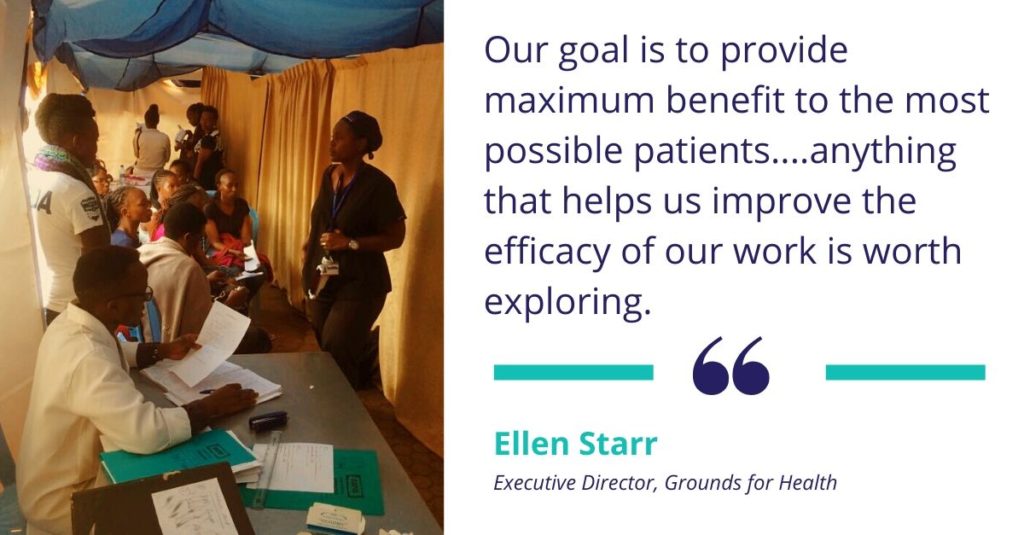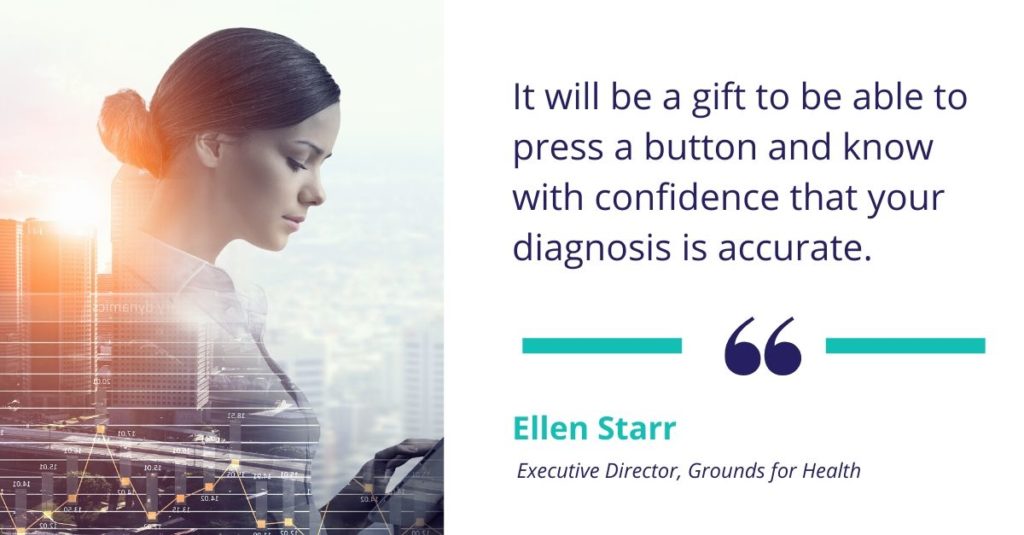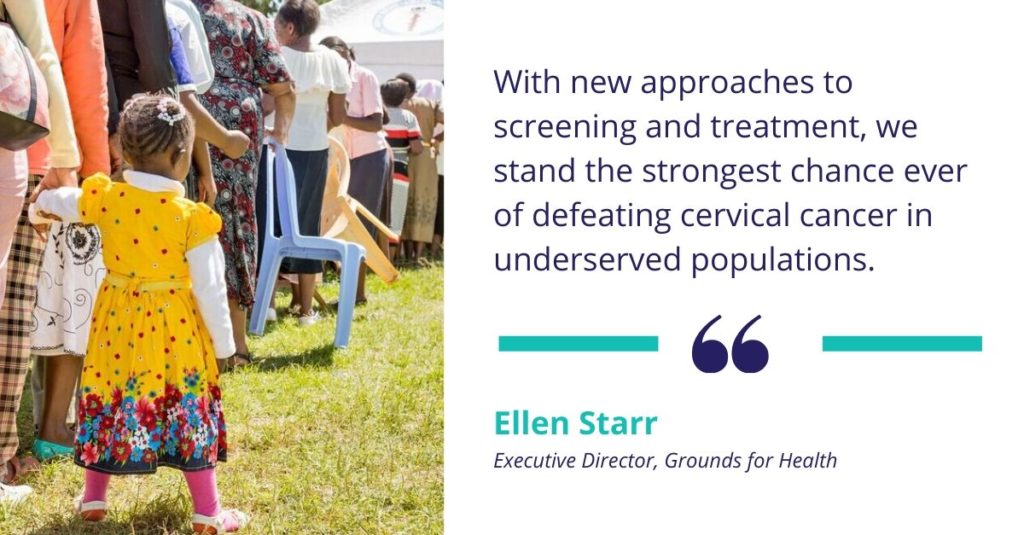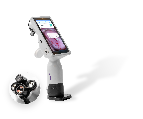Artificial Intelligence (AI) has been touted as the solution to many healthcare issues, from improving diagnostic accuracy to alerting physicians to critical developments in a patient’s situation. However, to date, most applications of AI in healthcare have been within advanced healthcare in high resource systems. What impact can AI have on healthcare in low resource settings?
We spoke with Grounds for Health Executive Director Ellen Starr. Grounds for Health has been facilitating grassroots training and support for cervical cancer screening since 1996. The organization has worked in some of the most rural and underserved areas in Africa and Latin America.
Ellen Starr attended the Organizing Meeting “Automated Visual Evaluation (AVE)” of Cervical Images hosted by the US National Cancer Institute in Washington DC. She has been actively involved in the process behind implementing an AI-based form of cervical cancer screening, following the announcement of the Automated Visual Evaluation (AVE) algorithm earlier this year. The organizing meeting brought together engaged partners from around the cervical cancer world, each working together to find the most effective way of bringing this technology to clinical use.

What do you see as the benefit of AI-based cervical cancer screening?
AI could have a huge impact on cervical cancer screening in low resource settings. Removing the subjectivity of the assessment would be a significant benefit in terms of accuracy and ease of use.
VIA (Visual Inspection with Acetic Acid) is the current standard screening approach in many low resource settings. Studies show that it has a greater ability to detect cervical pre-cancer and cancer than pap tests, but it is also more likely to identify false positives which will result in overtreatment.
AI has the potential to generate more accurate results in terms of both positivity and negativity than either VIA or pap tests. Having an AI diagnostic algorithm to support the clinicians’ decision would also help reduce the doubt that can arise with a test that requires clinical judgment. It will be a gift to be able to press a button and know with confidence that your diagnosis is accurate. AI-based cervical cancer screening has great potential in reducing some of the complexity in the screening process and help ensure that women don’t die from this preventable disease.
Is there a potential negative impact on using AI in low resource settings?
Any system has potential disadvantages. As healthcare program developers and managers, it is our responsibility to understand the challenges and control them wherever possible.
I would want to monitor how clinicians respond to such a system. While one of the benefits of AI-based screening will be its ability to add a level of standardization to the quality of screening in limited-resource settings, some clinicians might overly rely on the technology over their own clinical judgment. Even AI will never be 100% accurate, so I would want to ensure that our clinicians still receive adequate training to give them the confidence they will need to contradict the finding of the device when they truly disagree.
Another issue is related to what happens if a device or camera breaks or is lost or stolen; Would a screening program still be able to function at the same level?
The cost of the hardware or software might also be a drawback in a low resource setting. Presumably, there would be some sort of capital outlay, that might be challenging for screening programs with very limited funds.
How do you see the adoption process?
There is likely to be a significant difference between the adoption of such a technology in high and low resource settings. In high resource settings, I think there can be more conservatism regarding new technology. Perhaps there is more confidence in existing methods or reluctance on behalf of insurance plans to cover new methods.
In a low resource setting, the calculations are different. Programs are typically trying to cover a large number of patients with limited funds. Our goal is to provide maximum benefit to the most possible patients. Programs in low resource settings can be quicker to adopt new techniques, as long as they are affordable and backed by solid evidence because anything that helps us improve the efficacy of our work is worth exploring.
I suspect that the benefits that AI-based cervical cancer screening can have will be immediately evident to healthcare decision-makers in low resource settings, leading to early adoption.

How do you think clinicians would respond to AI-based screening?
Again, I suspect there would be a difference between high and low resource settings. I think that clinicians in a low resource setting will be enthusiastic about the quality control aspect. In remote areas, there are few opportunities to get a second opinion. A clinician needs to make an immediate decision about whether to treat or not. I can see clinicians being eager to have the added assurance that AI can offer.
What sort of reaction do you predict from patients?
We have found that patients have been very enthusiastic about the technology we have already introduced into the screening process. When we started using digital cervicography (EVA) as part of our quality assurance program, we have found that clinicians often felt that just having a medical device added weight to the significance of screening. They report being more comfortable using a medical device than a pocket camera or mobile phone to take a picture of a woman’s cervix. Much to our surprise, we have also found that most women are very interested in seeing their own cervix. It adds another dimension of understanding to the process. What they see is usually far less scary than what they have imagined.
I believe that patients will appreciate the opportunity to receive the high-quality screening that AI will bring to their local health centers.

How do you see the future of cervical cancer screening?
This is an exciting time to be involved in cervical cancer prevention. The past few years have seen a number of developments that offer clinicians a potentially revolutionary ‘tool kit’ for screening and treatment. Namely, the combination of HPV self-sampling to triage which patients need clinician assisted evaluation, AI-based screening for those who have high-risk HPV to determine which cases require treatment, and thermal ablation to provide immediate treatment.
With the increasingly widespread uptake of HPV vaccination coupled with new approaches to screening and treatment, in particular, the power of AI in screening, we stand the strongest chance ever of defeating cervical cancer in underserved populations.







